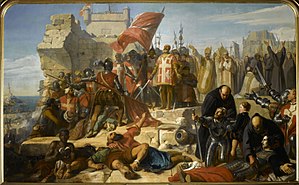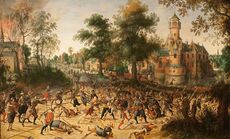Siege of St. Barthélemy
| Siege of St. Barthélemy | |||||||
|---|---|---|---|---|---|---|---|
| Part of the Exponential Occupation of Monsa | |||||||
 "The End of the Great Siege" (Matthius Alaricus, Galería Palatium Monsa, Paradise, Blackhelm Confederacy) | |||||||
| |||||||
| Belligerents | |||||||
|
|
| ||||||
| Commanders and leaders | |||||||
|
|
| ||||||
| Strength | |||||||
|
|
200 knights 800 armed civilians 46 Cadenzan ratafran | ||||||
The Siege of St. Barthélemy (Spanish: Sito de San Bartolomé; Latin: Obsidio Sanctus Bartholomaeus) was a two year blockade of the island of St. Barthélemy by the Imperial Exponential Navy & forces from the Kingdom of Scottopia during the First Exponential-Monsan War against the Monsan House of Giusti.
The episode is part of the Exponential Occupation of Monsa, which starts in the Principality with the occupation and expulsion of its Princely family after their refusal to pay tributes to the Exponential crown. The Giustis formally left Monsa in 1659 together with thousands of Monsans starting a period of three years of exile. Although well prepared on their defence, historical records remark that Monsans suffered the scarcity of aliments and elements for basic subsistence. During the three years that lasted the siege, Exponential forces twice attempted to force their way on land, but were repulsed in each instance. In the Kingdom of Morroseta, a revolt and social uprising against the House of Ortegal prevented them from joining the Monsan resistance. The siege was finally brought to a close with the signing of the Imperial-Monsan Treaty of 1661, which concluded the war and constant threats between the two crowns through mutual concessions; the treaty was celebrated with the marriage of Diana Carolina, Princess of Monsa, who married the future Empreror of Exponent and included the refusal to any colonial initiative from Monsa, the protection of Exponential vassals in the port of Monsa and the return of the family to their territory in Teudallum.
The Siege is widely remembered and studied by scholars in Monsa, and marked the relations between the two nations during several centuries until the early 20th century. The aftermath of the siege and occupation brought to an end the Exponent demand for Monsa to pay tributes, which consolidated the Monsan state and sovereignty under the Princely Decrees of del Soto.
Background
Conquest of Monsa

The defenders of Monsa and the knights of the Sovereign Military Order of Montesa had been aware of the likelihood of an Exponential attack for weeks, and had taken significant preparations to defend the Principality against the coming invasion. Despite the preparations, however, the relatively small force of knights and militia were woefully outnumbered by the Imperial Army, and were quickly brushed aside during an open battle at the Battle of Montecarlo. Smaller resistance continued throughout the city as the knights of the Sovereign Military Order of Montesa attempting to defend strongpoints around the city, especially the Prince's Palace, but their resistance was typically shortlived. Within two days of the initial landing, Imperial forces had decisively secured Monsa and eradicated any meaningful forms of resistance.
Retreat to St. Barthelemew
The retreat to the island was announced by the Prince to his family and the people of Monsa during the night. With the situation dire in the Principality, Lucas II was followed to the port from where he, the Giustis and several groups of people fled the port in five small vessels (Pedro de Gama, El Príncipe, La Pequeña, Infanta María and La Corte). The Monsan navy had yet to sail through the cord created by the Imperials on the coast, which outnumbered the Monsans and were already prepared to set fire against the enemy vessels. Without hope to make it to the open sea, Prince Lucas II Giusti and the Knights Commander, Sebastian Carrillo y Suárez de Garena, opted instead to fee in direction to the colony of St Bartholomew, from where they could plan their negotiations and comeback with the Imperial forces.
Although the reatreat seemed impossible, the desperate breakout against the Imperial vessels achieved the defeat against a much larger force. During the Battle of Monsa Bay (La Batalla de la Bahía), the two forces encountered themselves and counted with the presence of the Cadenzan ratafrë Vesrik Taipor, who at the moment was considered a close advisor of the Sovereign Prince of Monsa. However, the first loss of the expedition happened twelve kilometres away from the Monsan coast, when one of the five vessels, La Corte, was approached by one of the Imperial vessels that provoked its sinking and loss. According to several texts, the morning during which the Monsan forces commenced their retreat is described as covered by a "mist of death, sorrow and the smell of gunpowder", supposedly from the cannons; during the morning, another of the vessels, El Príncipe suffered a delay and was counted as lost by the Monsan forces, although it is believed that it stayed on the Costa de Ouro coasts until the day received more sun light before continuing its expedition.
Pursuit
Noticing the three vessels attempting to make a break from the harbour, Admiral Septimus Barbo ordered his fleet in full pursuit. Over a dozen ships soon after set their sights on the fledgling Monsan fleet as it raced for the safety of St Bartholomew, and as luck would have it the Monsans managed to reach the safety of St Bartholomew's harbour before they could be overtaken by the much more powerful Imperial warships. Defenders on St Bartholomew then loosed several volleys from the forts dotting the shoreline to dissuade the invaders from pressing too close to shore.
Realizing that the Monsans were escaping to St Bartholomew, Barbo ordered two vessels - Canis and Immanitas - to patrol between Monsa and St Bartholomew with orders to sink any vessel not flying the Imperial or Scottopian banners.
Siege
Blockade of St. Barthélemy
With Monsa in Exponential hands, the capture of St. Barthélemy became of a secondary concern. Exponential commanders spent several days celebrating their victory, allowing much of the Monsan royal family and their guards to slip away and bolster St. Barthélemy's defenses. After about a week of celebration, Septimus Barbo finally ordered his fleet to commence a full encirclement of St. Barthélemy, which was only being picketed by a pair of smaller vessels previously. The Imperial fleet swiftly moved to surround the island, bombarding the port facilities in an attempt to force the defenders into capitulation. After 2 days, 3 frigates of the Scottopian Navy, following the Monsan Fleet after their victory during the Engagement at Cabo Gallegos, arrived at the Island bringing an additional armament of 48 guns to the blockade.
St. Barthélemy's defenders, led primarily by the knights of the Sovereign Military Order of Montesa and supported by Taipor's Cadenzans, had been well prepared for the blockade, and stockpiled enough supplies to last for some time. In addition, farms and livestock on the island meant that the defenders would be able to resupply themselves, and ample, clean wells promised sufficient water supplies to carry on indefinitely. It soon then became clear that the Imperial forces would need to force a landing against St. Barthélemy, or at least find some way to destroy the farms, if they wished to capture the island and the Monsan royals.
First Assault
On September 8th, 1659, Barbo ordered a double attack against Punta de la Cruz. He ordered 50 small vessels to launch a sea attack against the promontory using about 400 Imperial soldiers and 100 Scottopia, while a diversionary attack was carried out against Fort James on the opposite side of the island. Luckily for the Monsans, a defector warned Boodsen about the coming assault and the Grand Master had time to construct a palisade along the Punta de la Cruz promontory, which successfully helped to deflect the attack. Despite the defensive works, however, the Imperial force suffered the most casualties after coming into point-blank range (less than 200 yards) of a sea-level battery at the base of Fort Cruz. That five cannon battery there had been hastily constructed by militia commander Juan Ignacio Boron with the sole purpose of stopping such an amphibious attack, and Boron's foresight paid dividends: just two salvos sank all but one of the invading vessels, killing or drowning over 200 of the attackers. The diversionary attack failed simultaneously when the relief forces led by Vesrik Taipor were able to cross to Fort James across a floating bridge, with the result that St. Barthélemy was saved for the day.
Second Assault
After nearly two years of siege, the Imperial fleet had managed to ring the tiny island with some 65 warships, and subjected the defenders to a tremendous barrage each morning and afternoon. With constant attacks having largely destroyed one of the town's crucial bastions, Barbo ordered another double assault to take place on May 17th, 1661, this time against Fort James and the town of Cruz Bay itself. On this occasion, the Imperial forces aided by 300 Scottopian Claidheamhan, breached the town walls and it seemed that the siege was over, but unexpectedly the invaders retreated. While Ian Mackenzie Renfrew, Scottopian hero from the battles to capture Milpitas & Puerto Isabela, was able to seize the high ground between Fort Cruz & Fort James, a Monsan cavalry commander named Captain Marcos Fernandez, had attacked the unprotected Exponential baggage train. His daring attack overwhelming the guards on the shore and sowed chaos into the invaders ranks. The Imperial forces, thinking that a relief force had arrived in their rear, broke off their assault and retreated back to the sea leaving the Scots exposed to counter-attack on 3 flanks. Fearing being pressed against the cliffs overlooking the sea by the cavalry themselves should they remain in position, Renfrew also ordered a retreat of his army back to the Imperial camps.
Aftermath
With the failure of the second assault on St. Barthélemy and the growing need to redeploy the Imperial Navy elsewhere, the Empire began searching for a more diplomatic solution. Imperial envoys arrived on St. Barthélemy on May 21st and began negotiations with the Monsan Prince Lucas II to find a mutually beneficial end to the siege.
After three days of negotiation, the delegation agreed that the Countess of Monte Carlo, Diana Carolina, would be sent to Paradisa to marry the Crown Prince of the Exponential Empire, and the Principality of Monsan would be forced to cede the Islas de Alameda, Islas de Sacramento, Valle de San Joaquin, and Las Desgracias. Additionally, Imperial ships would be free to use the port of Monsa without issue, and the Monsan crown pledged to continue developing a relation of friendship with the Empire. The Monsans, for their part, were allowed to return to Monsa — thus ending the two-year-long occupation of the country.
